Cover image: Crimson-breasted Shrike by Ryan Tippett – Carnarvon district, Northern Cape – BirdPix No. 97082
The Crimson-breasted Shrike belongs to the Bushshrike family MALACONOTIDAE. Other members of this group include Boubou’s, Tchagra’s, Bushshrikes and Puffbacks. They are smallish passerine birds with robust bodies, strong legs and feet, and formidable shrike-like bills. Many are very colourful and most species are rather secretive. The majority occur in woodlands, but also in marshes, scrub and Afromontane or tropical forest. They were formerly classed with the true shrikes in the family Laniidae, but are now considered sufficiently distinctive to be separated from that group. The family is endemic to sub-Saharan Africa but is completely absent from Madagascar. The name Malaconotidae alludes to their fluffy back and rump feathers.
Identification
The Crimson-breasted Shrike is an eye-catching and highly distinctive species.
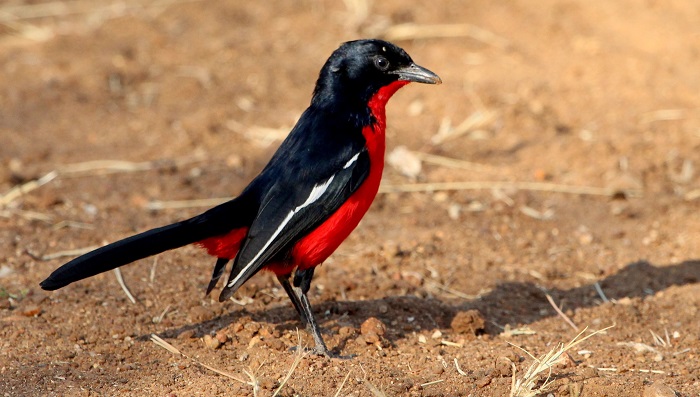
Tswalu Kalahari Reserve, Northern Cape
Photo by Kyle Finn
In adults, the upperparts, including the top and sides of the head, back, wings, and tail are entirely glossy jet black with a conspicuous white stripe on the folded wing. The underwing coverts are black. The underparts, from the chin to the vent, are bright crimson red or, rarely, bright yellow, and the thighs are black. The eyes are dark purplish-grey and the bill, legs, and feet are black. The sexes are alike.

Garingboom Guest Farm, Free State
Photo by Phillip Nieuwoudt
Juveniles have black upperparts with fine, buff-brown barring. The underparts are greyer with fine greyish-brown barring and the undertail coverts are crimson. During transition into adult plumage, the underparts become blotched in brown and crimson.
The striking plumage of the Crimson-breasted Shrike means it is very unlikely to be mistaken for any other southern African bird species. It is closely related to other Laniarius bushshrikes, but the other southern African species such as the Southern Boubou (Laniarius ferrugineus) carry far less colourful plumage.
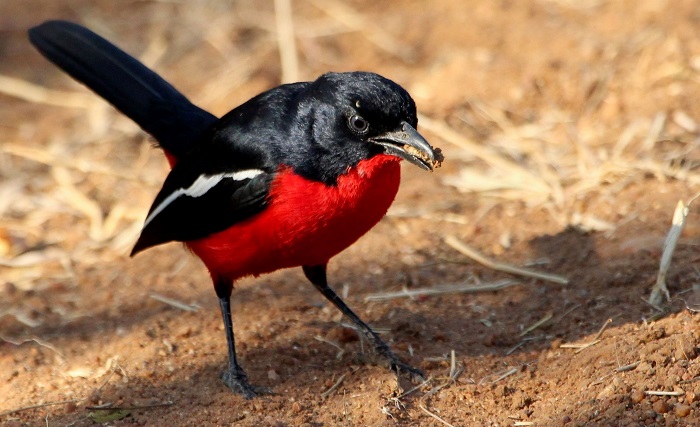
Stillbosch Wildlife Estate, Gauteng
Photo by Cameron Meyer
Status and Distribution
The Crimson-breasted Shrike is a common resident and is near-endemic to southern Africa.
It ranges from southern Angola and south-western Zambia down to South Africa. In southern Africa, it occurs across most of Namibia and throughout Botswana to western Zimbabwe and into South Africa. In South Africa it is found in the western parts of the Limpopo Province, north-western Mpumalanga, northern Gauteng, throughout the North West province and extreme north-western Free State. It is also widespread in the Northern Cape, mainly north of the Orange River. The Crimson-breasted Shrike avoids the mostly treeless regions of the Namib and Karoo. It is also absent from seemingly suitable thornveld habitat in the north-eastern lowveld and is a vagrant to the Kruger National Park, South Africa.
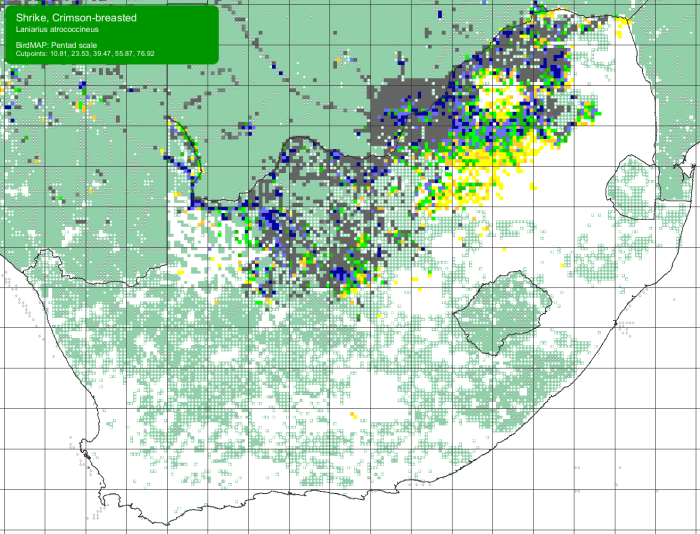
Details for map interpretation can be found here.
The Crimson-breasted Shrike is widespread, and common across its extensive range, and does not seem to be threatened in any way. Bush encroachment, particularly by Dichrostachys and Vachellia (Acacia) in response to over-grazing has created much additional habitat for the species.
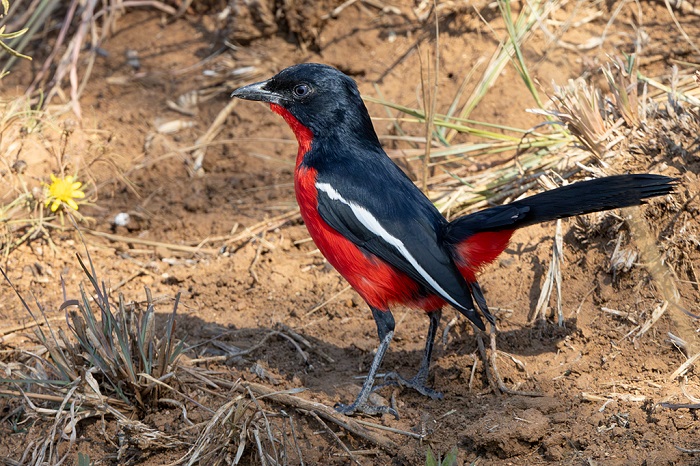
Carnarvon District, Northern Cape
Photo by Ryan Tippett
Habitat
The Crimson-breasted Shrike is a Vachellia (Acacia) woodland specialist. It favours dry Vachellia (Acacia) savanna and semi-arid scrub with scattered clumps of small trees, and particularly Kalahari thornveld. It is most numerous in the northern and central Kalahari, but less so in the more open southern Kalahari. Its presence in other woodland types, such as Mopane woodland and mixed woodlands are due to the extensive occurrence of Vachellia (Acacia) thickets within these habitats.

Mokala National Park, Northern Cape
Photo by Karis Daniel
Behaviour
The Crimson-breasted Shrike is a resident and sedentary species but may move locally into riverine woodland during the dry non-breeding season.
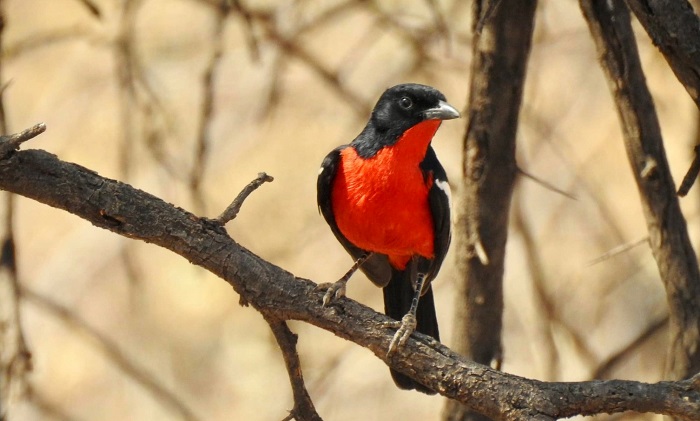
Near Oviston, Eastern Cape
Photo by Jorrie Jordaan
They are usually found in territorial pairs, or occasionally alone. The Crimson-breasted Shrike is agile and active, constantly changing its posture accompanied by jerks or swings of the tail. They are highly vocal and territorial pairs duet and counter-sing with excited interactions that include bowing, side-to-side movements and tail-jerking.
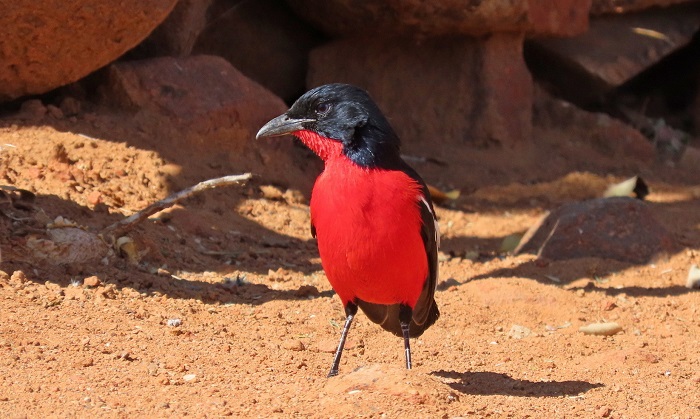
Vaalkop Dam Nature Reserve, North West
Photo by Lance Robinson
The Crimson-breasted Shrike has a characteristic upright posture when foraging on the ground, normally with the wing tips pointed down and the tail held horizontal but is jerked up and down with each hop. They generally only spend a few minutes on the ground at a time before scampering up through a bush or low tree branches, zigzagging from branch to branch until hidden. Roosts on the mid- to lower branches of a thorn tree. Pairs sleep 1 to a few meters from each other, sitting pressed against a tree trunk at the base of a thick branch. The flight heavy, with shallow wing-beats.
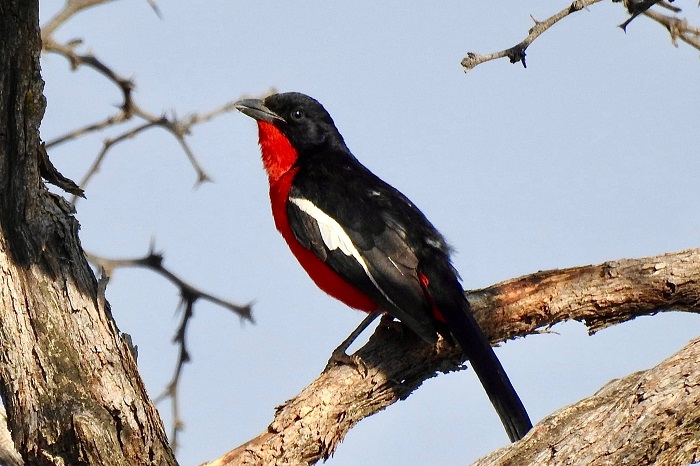
Karoo Gariep Nature Reserve, Northern Cape
Photo by Keir Lynch
Most foraging takes place in trees and on tree trunks. They spend less time foraging on the ground and will on occasion also hawk insects in the air. On the ground, they flick bits of vegetation aside, in much the same manner as a thrush. The Crimson-breasted Shrike sometimes forages in association with other bird species like Southern Pied Babblers, Arrow-marked Babblers, African Hoopoes and Common Scimitarbills.
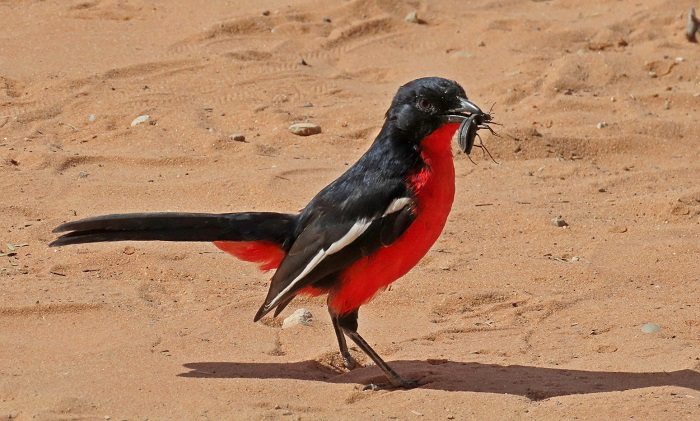
Sediba Game Lodge, North West
Photo by Lance Robinson
The diet consists mainly of invertebrates, including beetles, ants, caterpillars, grasshoppers, etc. They will also feed on small fruits when available, especially those that have fallen to the ground.
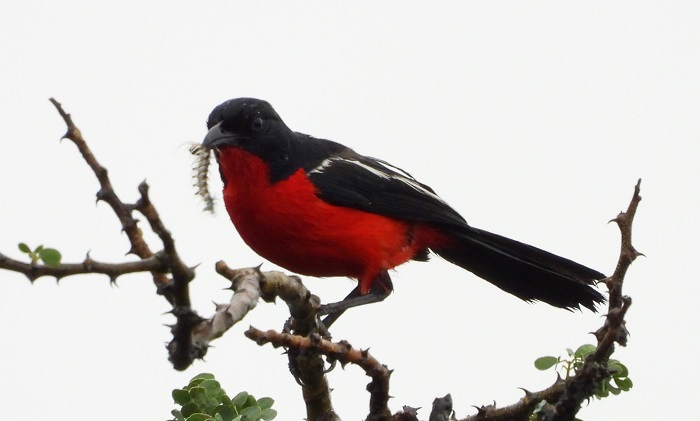
Carnarvon District, Northern Cape
Photo by Karis Daniel
The Crimson-breasted Shrike is territorial and is a monogamous and solitary nester. The nest is built by both sexes, usually in the early morning, and is completed in 4 to 6 days. The nest is a neat cup, built almost entirely of strips of bark collected from the branches and trunks of Vachellia (Acacia) trees by stripping the inside of bark peelings. Strips are then added by each bird in turn. The nest bowl is lined with rootlets and grass. The base of the nest is secured to branches with spider webs. It is usually placed 1 to 8 m above the ground in the vertical fork of the main stem, or more typically where the trunk and side branches diverge. The nest is placed less often on a horizontal or sloping fork.
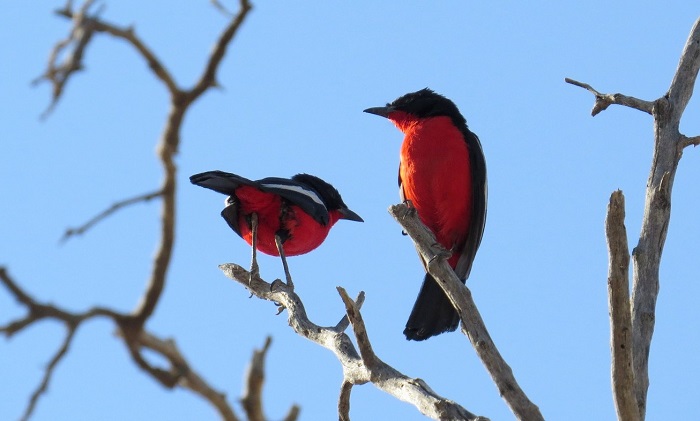
Carnarvon district, Northern Cape
Photo by Ryan Tippett
Eggs are laid throughout the summer months with a clear peak during October and November. The eggs are oval-shaped and buff coloured or very pale green, pale blue, or (occasionally) white. The eggs are speckled and spotted with browns and greys, and with underlying slate or lilac. 2 to 3 eggs are laid per clutch and incubation usually begins only once the second or third egg has been laid. The incubation period takes 15 to 17 days and is performed by both sexes. Pairs will re-lay after failure, starting a new nest 1 to 2 weeks after a lost clutch.
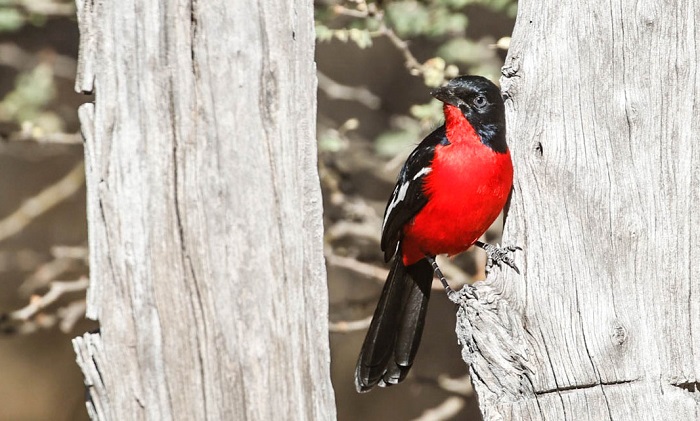
Alldays, Limpopo
Photo by Geoff Goetsch
The newly hatched young are born blind, naked and feeble but they develop quickly and are fully feathered at 10 days old. The young are brooded by their parents for the first 5 days or so, and are fed by both adults.
Both adults collect faecal sacs after feeding the chicks, either eating them, or carrying them away in the bill. This is done to keep the nest clean and hygienic and to prevent a smelly nest from attracting potential predators and pests. The young are ready to leave the nest after around 20 days, but stay close to the adults, although they mostly forage independently. The young roost in the same tree as their parents, each bird occupying a separate perch. The young may sometimes still remain with the adults when incubation of a second clutch starts.
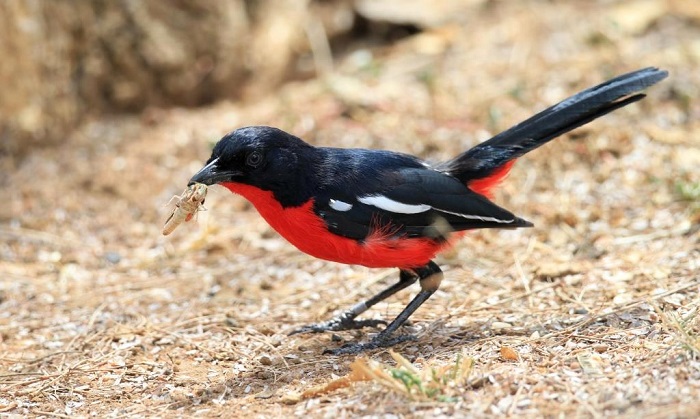
Doornkloof, Free State
Photo by Dewald du Plessis
The Crimson-breasted Shrike is single or double-brooded, with up to 4 nesting attempts per season. A new nest is often started 1 or 2 weeks after the previous brood has fledged. Clutches of the Crimson-breasted Shrike are sometimes parasitised by the Black Cuckoo.
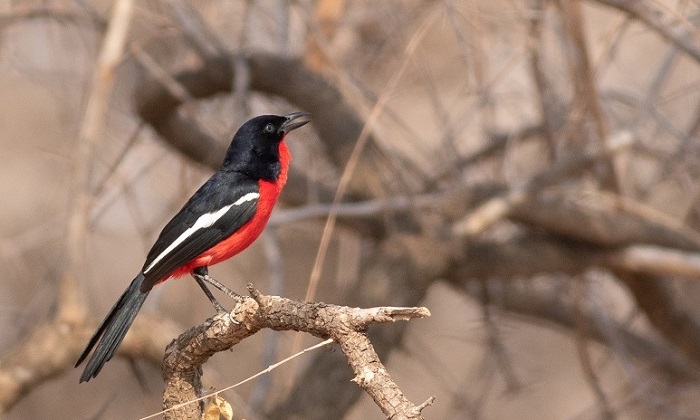
Doornkloof, Free State
Photo by Dewald du Plessis
Further Resources
Species text in the first Southern African Bird Atlas Project (SABAP1), 1997.
The use of photographs by Cameron Meyer, Dewald du Plessis, Geoff Goetsch, Jon Blanco, Jorrie Jordaan, Karis Daniel, Keir Lynch, Kyle Finn, Lance Robinson and Phillip Nieuwoudt is acknowledged.
Virtual Museum (BirdPix > Search VM > By Scientific or Common Name).
Other common names: Rooiwangnaguil (Afrikaans); Mahulwana, Ribyatsane (Tswana); Engoulevent à joues rousses (French); Roodwangnachtzwaluw (Dutch); Rostwangen-Nachtschwalbe (German); Noitibó-de-faces-ruivas (Portuguese).
List of bird species in this format is available here.
Recommended citation format: Tippett RM 2024. Crimson-breasted Shrike (Laniarius atrococcineus). Biodiversity and Development Institute. Available online at https://thebdi.org/2024/11/01/crimson-breasted-shrike-laniarius-atrococcineus/
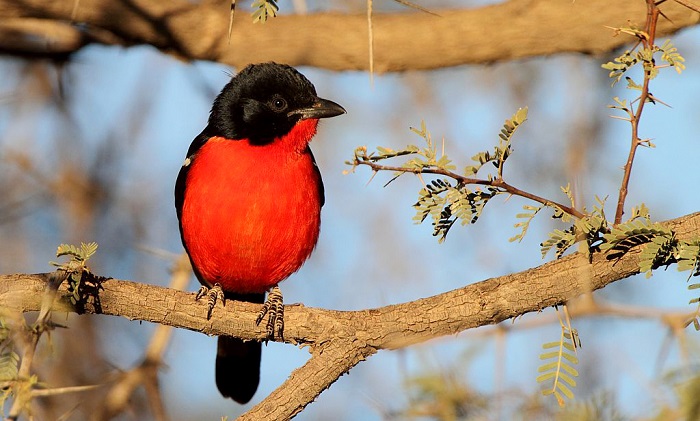
Carnarvon District, Northern Cape
Photo by Ryan Tippett


Please just correct ‘Other Common Names’